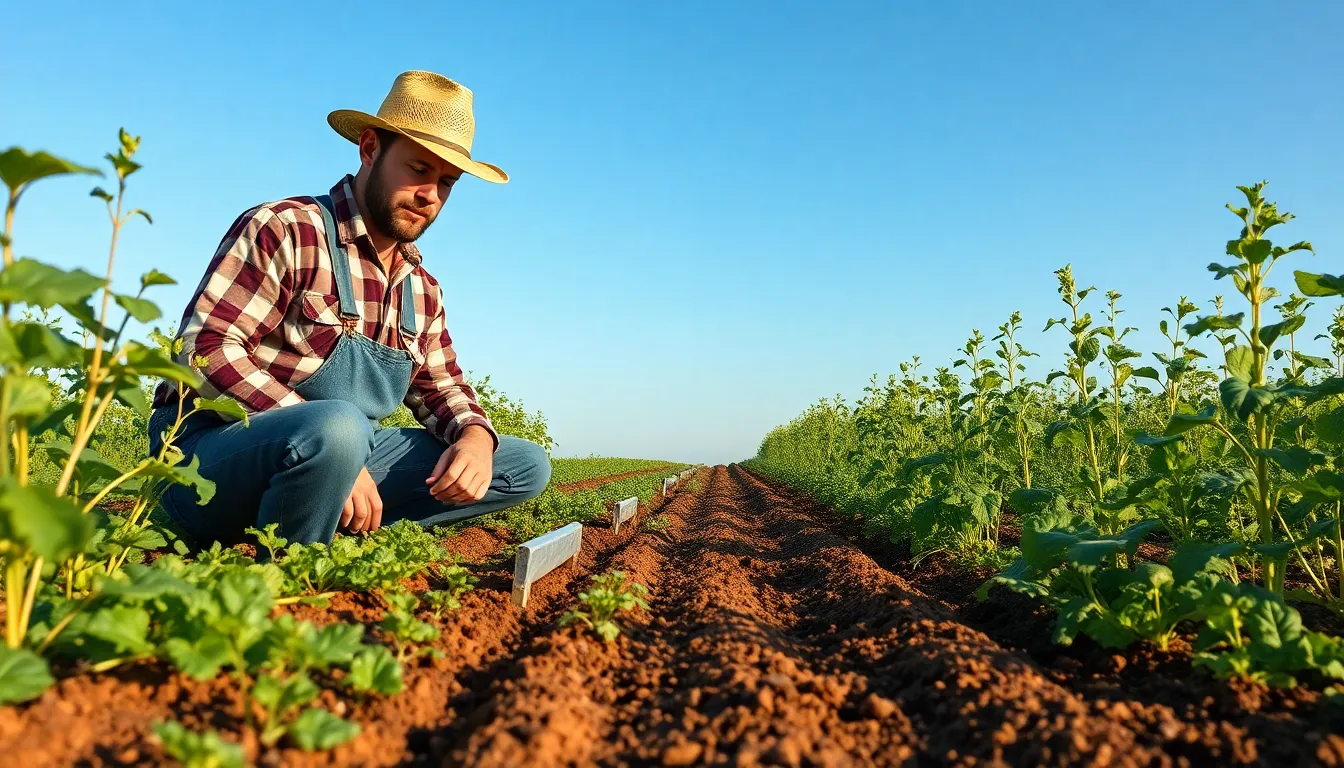In a world where climate change seems to be throwing a tantrum, farmers are stepping up with a superhero cape—welcome to the realm of climate-smart agriculture. This innovative approach isn’t just about growing crops; it’s about growing resilience, sustainability, and a future where food production doesn’t come at the expense of the planet.
Table of Contents
ToggleOverview of Climate-Smart Agriculture
Climate-smart agriculture promotes agricultural practices that bolster productivity while reducing greenhouse gas emissions. This approach integrates sustainable farming methods to enhance resilience against climate change impacts. By optimizing resource use, farmers can improve crop yield and conserve natural resources.
Practices such as crop rotation, intercropping, and agroforestry help maintain soil health. These methods also increase biodiversity on farms, making ecosystems stronger and more adaptable. Implementing precision agriculture maximizes efficiency by using technology to monitor and manage field variability.
Water management plays a critical role in climate-smart agriculture. Techniques such as rainwater harvesting and drip irrigation enhance water efficiency, ensuring crops receive adequate hydration. These strategies are vital in areas facing water scarcity or erratic rainfall patterns.
Furthermore, carbon sequestration is an essential component. Sustainable land management practices capture carbon from the atmosphere, contributing to climate mitigation efforts. By prioritizing these practices, farmers not only reduce their carbon footprint but also potentially generate additional income through carbon credit markets.
Collaboration among stakeholders strengthens the climate-smart agriculture framework. Farmers, researchers, and policymakers must share knowledge and resources to create effective strategies and adapt to evolving climate challenges. Initiatives like community-supported agriculture and educational programs foster a culture of innovation and sustainability within farming circles.
Benefits of Climate-Smart Agriculture

Climate-smart agriculture offers multiple benefits that enhance both environmental sustainability and economic viability. This approach effectively addresses the pressing challenges of climate change while promoting agricultural resilience.
Environmental Benefits
Enhanced biodiversity results from climate-smart practices like crop rotation and agroforestry. These methods improve soil health and enable ecosystems to adapt better to climate impacts. Water conservation techniques, such as drip irrigation and rainwater harvesting, optimize water use and reduce waste. Sustainable land management plays a vital role in carbon sequestration, helping to mitigate greenhouse gas emissions. Furthermore, integrating these environmentally friendly strategies fosters healthier ecosystems and promotes overall sustainability.
Economic Benefits
Economic advantages stem from increased productivity associated with climate-smart agriculture. Farmers adopting precision agriculture can optimize input use, reducing costs and improving yields. Access to carbon credit markets provides additional income opportunities for those implementing sustainable practices. Reduced vulnerability to climate-related disruptions further stabilizes farmer incomes. Overall, these economic benefits contribute to a more resilient agricultural sector, ensuring long-term viability for farming communities.
Key Practices in Climate-Smart Agriculture
Climate-smart agriculture includes several key practices that enhance resilience and sustainability in farming.
Sustainable Land Management
Sustainable land management practices prioritize soil health and productivity. Crop rotation benefits ecosystems by reducing pest populations and preventing soil depletion. Cover crops improve soil structure, enhance nutrient availability, and prevent erosion. Additionally, practices such as no-till farming decrease soil disturbance, promoting carbon sequestration. Training farmers in sustainable techniques fosters adaptive and resilient agricultural systems.
Water Conservation Techniques
Water conservation techniques play a critical role in climate-smart agriculture. Rainwater harvesting captures and stores rain, allowing farmers to utilize it during dry spells effectively. Drip irrigation systems deliver water directly to plant roots, minimizing waste and ensuring efficient use. Implementing these strategies increases resilience in water-scarce regions where managing water resources is essential. Monitoring soil moisture also helps optimize irrigation schedules, further conserving water.
Agroecological Approaches
Agroecological approaches enhance biodiversity and ecosystem services in agricultural systems. Intercropping, a method that involves growing different crops together, promotes resource sharing and improves pest management. Using native plant species helps restore local ecosystems and increases resilience to climate variability. Integrated pest management combines biological control with minimal chemical use, reducing environmental impact. Educating farmers about agroecology supports innovation and sustainability in agricultural practices.
Challenges in Implementing Climate-Smart Agriculture
Implementing climate-smart agriculture presents significant challenges that hinder its adoption.
Policy and Institutional Barriers
Policies restricting innovation often limit the adoption of climate-smart practices. Regulations may not always accommodate new farming techniques, stifling creativity and progress. Additionally, a lack of supportive institutional frameworks creates confusion for farmers trying to navigate compliance requirements. Inconsistent policy enforcement further complicates the situation, making it harder to implement climate-smart agriculture effectively. Stakeholders must advocate for clearer, more cohesive policy frameworks that facilitate the transition to sustainable practices.
Financial Constraints
Financial limitations serve as a major barrier to implementing climate-smart agriculture. Many farmers face difficulties accessing capital for investing in new technologies and sustainable practices. While there may be opportunities for grants and loans, complex application processes can discourage participation. Without adequate financial support, farmers struggle to adopt necessary changes, particularly in resource-limited settings. Ensuring accessible financing options, tailored advice, and incentives for adopting climate-smart approaches can empower farmers to invest in sustainable practices.
Embracing climate-smart agriculture is crucial for building a resilient and sustainable future in farming. By integrating innovative practices that enhance productivity while minimizing environmental impact, farmers can adapt to the challenges posed by climate change. This approach not only supports biodiversity and soil health but also optimizes water use and fosters economic opportunities.
Collaboration among farmers, researchers, and policymakers is essential to overcoming barriers and sharing knowledge. With accessible financing and supportive frameworks, the transition to climate-smart practices becomes more attainable. As the agricultural sector evolves, prioritizing sustainability ensures long-term viability and reduces vulnerability to climate-related disruptions. The commitment to climate-smart agriculture paves the way for a healthier planet and thriving farming communities.

